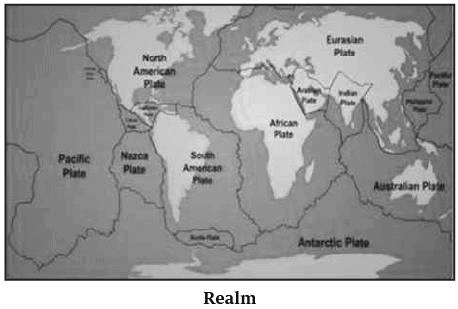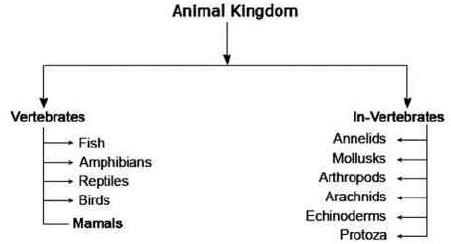Indian Biodiversity Diverse Landscape | Environment for UPSC CSE PDF Download
- India is recognised as one of the mega-diverse countries, rich in biodiversity and associated traditional knowledge. With just 2.4% of the land area, India accounts for nearly 7% of the recorded species even while supporting almost 18% of the human population.
- In terms of species richness, India ranks seventh in mammals, ninth in birds and fifth in reptiles. The varied Edaphic, Climatic and Topographic conditions have resulted in a wide range of ecosystems and habitats such as forests, grasslands, wetlands, coastal and marine ecosystems, and deserts in India with greater biodiversity.
India Represents
(a) Realms: Biogeographic realms are large spatial regions where ecosystems share a broadly similar biota. The realm is a continent or sub-continent-sized area with unifying features of geography and fauna & flora.
The Indian region is composed of two realms. They are:
- the Himalayan region represented by Palearctic Realm and
- the rest of the sub-continent represented by Malayan Realm

➤ Eight terrestrial biogeographic realms are recognized
- Nearctic realm
- Palearctic realm
- Africotropical realm
- Indo-Malayan realm
- Oceania realm
- Australian realm
- Antarctic realm
- Neotropical realm
(b) Biomes of India: The term biome means the main groups of plants and animals living in areas of certain climate patterns. It includes how animals, vegetation and soil interact together. The plants and animals living in the area are adapted to that environment.
➤ The five biomes of India are
- Tropical Humid Forests
- Tropical Dry or Deciduous Forests (including Monsoon Forests)
- Warm deserts and semi-deserts
- Coniferous forests and
- Alpine meadows.
(c) Bio-geographic Zones

Biogeography deals with the geographical distribution of plants and animals. There are 10 biogeographic zones which are distinguished clearly in India.
➤ They are as follows
- Trans-Himalayas: An extension of the Tibetan plateau, harbouring high-altitude cold desert in Laddakh (J&K) and Lahaul Spiti (H.P) comprising 5.7 % of the country’s landmass.
- The Himalayas: The entire mountain chain running from north-western to northeastern India, comprising a diverse range of biotic provinces and biomes, 7.2 % of the country’s landmass.
- Desert: The extremely arid area west of the Aravalli hill range, comprising both the salty desert of Gujarat and the sand desert of Rajasthan. 6.9% of the country’s landmass.
- Semi-arid: The zone between the desert and the Deccan plateau, including the Aravalli hill range. 15.6 % of the country’s landmass.
- The Western Ghats: The hill ranges and plains running along the western coastline, south of the Tapti river, covering an extremely diverse range of biotic provinces and biomes. 5.8% of the country’s landmass.
- Deccan peninsula: The largest of the zones, covering much of the southern and southcentral plateau with predominantly deciduous vegetation. 4.3 % of the country’s landmass.
- Gangetic plain: Defined by the Ganges river system, these plains are relatively homogenous. 11% of the country’s landmass.
- North-east India. The plains and non-Himalayan hill ranges of northeastern India, with a wide variety of vegetation. 5.2% of the country’s landmass.
- Islands: The Andaman and Nicobar Islands in the Bay of Bengal, with highly diverse biomes set. 0.03% of the country’s landmass.
- Coasts: A large coastline distributed both to the west and east, with distinct differences between the two; Lakshadeep islands are included in this with the per cent area being negligible.
➤ Biogeography is divided into branches
- Phyto -geography (plant geography) deals with origin, distribution and environmental interrelationships of plants.
- Zoogeography deals with the migration and distribution of animals.
(d) Bio-geographic provinces
- Bio-geographic Province is an ecosystemic or biotic subdivision of realms. India is divided into 25 biogeographic zones.
- Biogeographic classification of India was done by Rodgers and Panwar (1988), describing 10 biogeographic zones in India, further divided into 25 biogeographic provinces.
- The classification was done using various factors such as altitude, moisture, topography, rainfall, etc. Biogeographic zones were used as a basis for planning wildlife protected areas in India.
Biogeographic zones and Biogeographic Provinces of India
 FAUNA
FAUNA
Vertebrates
Vertebrates are animals with backbones and spinal columns. Vertebrates are the most advanced organisms on Earth. Although vertebrates represent only a tiny percentage of all animals, their size and mobility often allow them to dominate their environment.
➤ Fishes
- Cold-blooded
- Live in water
- Breathe underwater using gills, not lungs
- Have scales and fins
- Lay eggs
➤ Amphibians
- Cold-blooded
- Live on land & water
- Webbed feet
- Breathe with lungs and gills
- Moist smooth skin
- Four legs (sometimes none)
- Lay eggs
➤ Reptiles
- Cold-blooded
- Have scales
- Have dry skin
- Usually, lay eggs
- Ear holes instead of ears
- 4 legs or no legs
➤ Aves
- Warm-blooded
- Have feathers and wings
- Lay eggs
- Have 2 legs
- Ear holes instead of ears
➤ Mammals
- Warm-blooded
- Have hair or fur
- Give birth to live young ones
- Mammal mother nurse their young one with milk
- Breathe with lungs
- Mammals live on land have 4 legs (or 2 legs & 2 arms), and ears that stick out.
➤ Invertebrates
- Invertebrates do not have backbones. More than 98% of animal species in the world are invertebrates. Invertebrates don’t have an internal skeleton made of bone. Many invertebrates have a fluid-filled, hydrostatic skeleton, like the jellyfish or worm. Others have a hard outer shell, like insects and crustaceans.

➤ Annelids
- Annelids have bodies that are divided into segments.
- They have very well-developed internal organs.
- Found almost anywhere in the world.
- They don’t have any limbs.
- E.g., earthworms, leeches, roundworms, etc.
➤ Mollusks
- Most molluscs have a soft, skin-like organ covered with a hard outside shell.
- Some molluscs live on lands, such as the snail and slug.
- Other molluscs live in water, such as the oyster, mussel, clam, squid and octopus.
➤ Echinoderms
- Echinoderms are marine animals that live in the ocean.
- Most echinoderms have arms or spines that radiate from the centre of their body.
- Common echinoderms include the sea star, sea urchin, sand dollar and sea cucumber.
➤ Protozoa
- Protozoa are simple, single-celled animals.
- They are the smallest of all animals.
- Most protozoa are microscopic.
- They do breathe, move and reproduce like multicelled animals.
- E.g., amoebas, Flagellates, etc.
➤ Arthropods
- Arthropods have limbs with joints that allow them to move.
- They also have an exoskeleton, which is a hard, external skeleton.
- Arthropods include the crustaceans and insects, arachnids.
➤ Crustaceans
- live mostly in the ocean or other waters.
- Crustaceans have a hard, external shell which protects their body
- Most commonly known crustaceans are the crab, lobster and barnacle.
➤ Insects
- Insects have an exoskeleton that covers their entire body.
- An insect’s consists of 3 body parts and 6 legs and a antennae
- E.g., beetle, butterfly, moth, dragonfly, bee, wasp and praying mantis.
➤ Arachnids
- Common arachnids are spiders, scorpions, ticks and mites.
- Arachnids do not have antennae.
- Arachnids have 2 body parts and 4 pairs of legs.
Floral Diversity
In terms of plant diversity, India ranks tenth in the world and fourth in Asia. India represents nearly 11% of the world’s known floral diversity.
|
95 videos|231 docs|52 tests
|
FAQs on Indian Biodiversity Diverse Landscape - Environment for UPSC CSE
| 1. What is the significance of India's diverse landscape in terms of biodiversity? |  |
| 2. How does India's diverse landscape contribute to the conservation of endangered species? |  |
| 3. What are some of the threats faced by India's biodiversity due to its diverse landscape? |  |
| 4. How does India's diverse landscape contribute to the cultural heritage of the country? |  |
| 5. What are some ongoing initiatives to protect and conserve India's biodiversity-rich diverse landscape? |  |
















